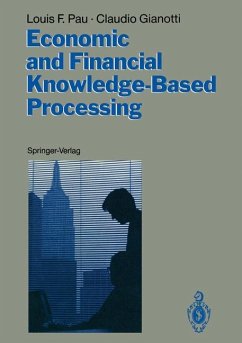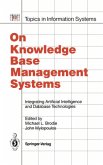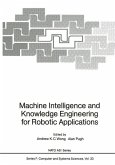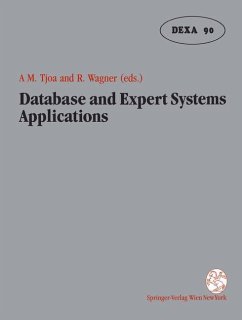- Broschiertes Buch
- Merkliste
- Auf die Merkliste
- Bewerten Bewerten
- Teilen
- Produkt teilen
- Produkterinnerung
- Produkterinnerung
As banks, financial services, insurances, and economic research units worldwide strive to add knowledge based capabilities to their analyses and services, or to create new ones, this volume aims to provide them with concrete tools, methods and application possibilities. The tutorial component of the book relies on case study illustrations, and on source code in some of the major artificial intelligence languages. The applications related component includes an extensive survey of real projects, and a number of thorough generic methods and tools for auditing, technical analysis, information…mehr
Andere Kunden interessierten sich auch für
![On Knowledge Base Management Systems On Knowledge Base Management Systems]() On Knowledge Base Management Systems41,99 €
On Knowledge Base Management Systems41,99 €![Expert Systems Lab Course Expert Systems Lab Course]() Peter SchnuppExpert Systems Lab Course41,99 €
Peter SchnuppExpert Systems Lab Course41,99 €![Machine Intelligence and Knowledge Engineering for Robotic Applications Machine Intelligence and Knowledge Engineering for Robotic Applications]() Machine Intelligence and Knowledge Engineering for Robotic Applications41,99 €
Machine Intelligence and Knowledge Engineering for Robotic Applications41,99 €![Constraint Programming Constraint Programming]() Constraint Programming39,99 €
Constraint Programming39,99 €![Database and Expert Systems Applications Database and Expert Systems Applications]() Database and Expert Systems Applications42,99 €
Database and Expert Systems Applications42,99 €![AISB91 AISB91]() AISB9141,99 €
AISB9141,99 €![Intelligent Information Processing Intelligent Information Processing]() Intelligent Information Processing116,99 €
Intelligent Information Processing116,99 €-
-
-
As banks, financial services, insurances, and economic research units worldwide strive to add knowledge based capabilities to their analyses and services, or to create new ones, this volume aims to provide them with concrete tools, methods and application possibilities. The tutorial component of the book relies on case study illustrations, and on source code in some of the major artificial intelligence languages. The applications related component includes an extensive survey of real projects, and a number of thorough generic methods and tools for auditing, technical analysis, information screens and natural-language front-ends. The research related component highlights novel methods and software for economic reasoning under uncertainty and for fusion of qualitative/quantitative model-based economic reasoning.
Produktdetails
- Produktdetails
- Verlag: Springer / Springer Berlin Heidelberg / Springer, Berlin
- Artikelnr. des Verlages: 978-3-642-76004-4
- Softcover reprint of the original 1st ed. 1990
- Seitenzahl: 384
- Erscheinungstermin: 23. August 2014
- Englisch
- Abmessung: 244mm x 170mm x 21mm
- Gewicht: 662g
- ISBN-13: 9783642760044
- ISBN-10: 364276004X
- Artikelnr.: 41322222
- Herstellerkennzeichnung Die Herstellerinformationen sind derzeit nicht verfügbar.
- Verlag: Springer / Springer Berlin Heidelberg / Springer, Berlin
- Artikelnr. des Verlages: 978-3-642-76004-4
- Softcover reprint of the original 1st ed. 1990
- Seitenzahl: 384
- Erscheinungstermin: 23. August 2014
- Englisch
- Abmessung: 244mm x 170mm x 21mm
- Gewicht: 662g
- ISBN-13: 9783642760044
- ISBN-10: 364276004X
- Artikelnr.: 41322222
- Herstellerkennzeichnung Die Herstellerinformationen sind derzeit nicht verfügbar.
A reader's guide.- 0 Introduction.- 0.1 Introduction.- 0.2 The strategic challenge to banks and insurance.- 0.3 The strategic challenge to financial services.- 0.4 The strategic challenge to economic analysis and decision making.- 0.5 The strategic challenge for business management.- 0.6 Conclusion.- 1 Basic concepts.- 1.1 Introduction.- 1.2 Survey of AI applications in finance and economics.- 1.3 Case studies and examples.- 1.4 The mortgage loan credit granting case study.- 1.5 AI and Decision support.- 2 Applications of Artificial Intelligence in banking, financial services and economics.- 2.1 The motivations for the use of AI.- 2.2 Survey of development projects.- 2.3 Development and delivery environments.- 2.4 Generic domain utilities.- 2.5 Inference control and conflict resolution strategies.- 2.6 Table of projects.- 2.7 Project references.- 3 Knowledge Representation.- 3.1 Introduction.- 3.2 Case study: a tax adviser.- 3.3 The graph and tree data structures.- 3.4 Semantic networks.- 3.5 Logic.- 3.6 Rules.- 3.7 Frames.- 3.8 Temporal reasoning.- 4 Artificial Intelligence Programming Languages.- 4.1 Introduction.- 4.2 Language syntax and parsing.- 4.3 LISP.- 4.4 Prolog.- 4.5 Object-oriented programming.- 5 Search and causal analysis.- 5.1 Motivation.- 5.2 State-based representation of problems.- 5.3 Problem graphs.- 5.4 Search and knowledge.- 5.5 Search procedures.- 5.6 Application: a simple economic model in graph form.- 5.7 Simple propagation.- 5.8 Propagation with alternatives: depth-first.- 5.9 Introducing side effects: breadth-first.- 5.10 Case study: causal analysis in linear economic models.- 5.11 Heuristic search methods.- 6 Neural processing and inductive learnings.- 6.1 Introduction.- 6.2 Neural processing for learning and classification.- 6.3 Inductivelearning.- 6.4 Extensions to neural processing.- 7 Technical analysis for securities trading.- 7.1 Introduction.- 7.2 Curve generation by a syntactic grammar.- 7.3 Curve segmentation.- 7.4 Segmentation of noisy curves.- 7.5 Analysis evaluation rules.- 7.6 Technical analysis on several curves and software implementation.- 7.7 Time series analysis.- 7.8 Examples of concurrent trading rules.- 7.9 Off-line analysis for learning.- 7.10 Forecasting.- 7.11 Trade generation.- 8 Intelligent information screens.- 8.1 Introduction.- 8.2 Selective object-oriented data acquisition.- 8.3 Knowledge-based information screens.- 8.4 Knowledge-based filters for financial information screens.- 8.5 Information retrieval aspects.- 8.6 Data fusion.- 8.7 Correlation.- 9 Natural language front-ends to economic models.- 9.1 Introduction.- 9.2 Prolog parser for NL front-ends.- 9.3 Definite clause grammar in Prolog.- 9.4 Translation of DCG grammar rules into Prolog clauses.- 9.5 DCG parser.- 9.6 Reasoning from NL analysis.- 10 Trade selection with uncertain reasoning on technical indicators.- 10.1 Introduction.- 10.2 The theory of Dempster-Shafer.- 10.3 Pooling evidence.- 10.4 Application: pooling evidence about trading.- 11 Currency risk management.- 11.1 Introduction: risk planning over time.- 11.2 Single period model.- 11.3 Multi-period model.- 11.4 Knowledge-based risk management.- 11.5 Risk allocation procedure.- 12 Reasoning procedures in knowledge-based systems for economics and management.- 12.1 Introduction.- 12.2 Objects in decision analysis.- 12.3 Classification of decision methods.- 12.4 Logics and constraints.- 12.5 Truth maintenance as rational decision-making.- 12.6 Search over time and disequilibrium.- 12.7 Conflict resolution.- 12.8 Search over AND/OR graphs.- 12.9 Power relations and gaming for the selection of solutions.- Appendix 1 Software Codes.- Appendix 2 Predefined LISP and Prolog expressions 333.
A reader's guide.- 0 Introduction.- 0.1 Introduction.- 0.2 The strategic challenge to banks and insurance.- 0.3 The strategic challenge to financial services.- 0.4 The strategic challenge to economic analysis and decision making.- 0.5 The strategic challenge for business management.- 0.6 Conclusion.- 1 Basic concepts.- 1.1 Introduction.- 1.2 Survey of AI applications in finance and economics.- 1.3 Case studies and examples.- 1.4 The mortgage loan credit granting case study.- 1.5 AI and Decision support.- 2 Applications of Artificial Intelligence in banking, financial services and economics.- 2.1 The motivations for the use of AI.- 2.2 Survey of development projects.- 2.3 Development and delivery environments.- 2.4 Generic domain utilities.- 2.5 Inference control and conflict resolution strategies.- 2.6 Table of projects.- 2.7 Project references.- 3 Knowledge Representation.- 3.1 Introduction.- 3.2 Case study: a tax adviser.- 3.3 The graph and tree data structures.- 3.4 Semantic networks.- 3.5 Logic.- 3.6 Rules.- 3.7 Frames.- 3.8 Temporal reasoning.- 4 Artificial Intelligence Programming Languages.- 4.1 Introduction.- 4.2 Language syntax and parsing.- 4.3 LISP.- 4.4 Prolog.- 4.5 Object-oriented programming.- 5 Search and causal analysis.- 5.1 Motivation.- 5.2 State-based representation of problems.- 5.3 Problem graphs.- 5.4 Search and knowledge.- 5.5 Search procedures.- 5.6 Application: a simple economic model in graph form.- 5.7 Simple propagation.- 5.8 Propagation with alternatives: depth-first.- 5.9 Introducing side effects: breadth-first.- 5.10 Case study: causal analysis in linear economic models.- 5.11 Heuristic search methods.- 6 Neural processing and inductive learnings.- 6.1 Introduction.- 6.2 Neural processing for learning and classification.- 6.3 Inductivelearning.- 6.4 Extensions to neural processing.- 7 Technical analysis for securities trading.- 7.1 Introduction.- 7.2 Curve generation by a syntactic grammar.- 7.3 Curve segmentation.- 7.4 Segmentation of noisy curves.- 7.5 Analysis evaluation rules.- 7.6 Technical analysis on several curves and software implementation.- 7.7 Time series analysis.- 7.8 Examples of concurrent trading rules.- 7.9 Off-line analysis for learning.- 7.10 Forecasting.- 7.11 Trade generation.- 8 Intelligent information screens.- 8.1 Introduction.- 8.2 Selective object-oriented data acquisition.- 8.3 Knowledge-based information screens.- 8.4 Knowledge-based filters for financial information screens.- 8.5 Information retrieval aspects.- 8.6 Data fusion.- 8.7 Correlation.- 9 Natural language front-ends to economic models.- 9.1 Introduction.- 9.2 Prolog parser for NL front-ends.- 9.3 Definite clause grammar in Prolog.- 9.4 Translation of DCG grammar rules into Prolog clauses.- 9.5 DCG parser.- 9.6 Reasoning from NL analysis.- 10 Trade selection with uncertain reasoning on technical indicators.- 10.1 Introduction.- 10.2 The theory of Dempster-Shafer.- 10.3 Pooling evidence.- 10.4 Application: pooling evidence about trading.- 11 Currency risk management.- 11.1 Introduction: risk planning over time.- 11.2 Single period model.- 11.3 Multi-period model.- 11.4 Knowledge-based risk management.- 11.5 Risk allocation procedure.- 12 Reasoning procedures in knowledge-based systems for economics and management.- 12.1 Introduction.- 12.2 Objects in decision analysis.- 12.3 Classification of decision methods.- 12.4 Logics and constraints.- 12.5 Truth maintenance as rational decision-making.- 12.6 Search over time and disequilibrium.- 12.7 Conflict resolution.- 12.8 Search over AND/OR graphs.- 12.9 Power relations and gaming for the selection of solutions.- Appendix 1 Software Codes.- Appendix 2 Predefined LISP and Prolog expressions 333.








